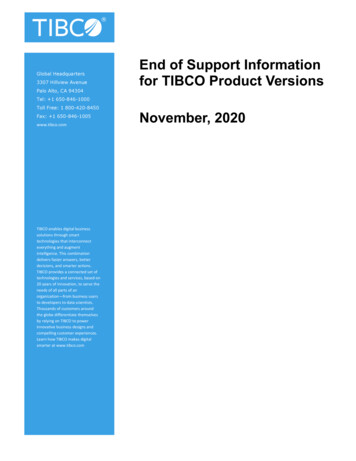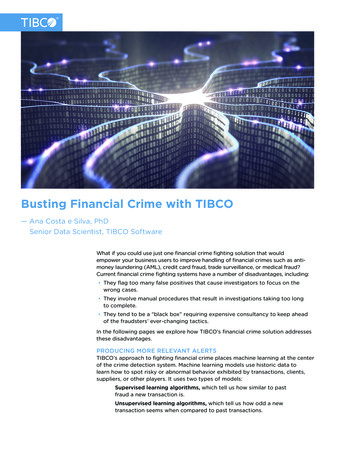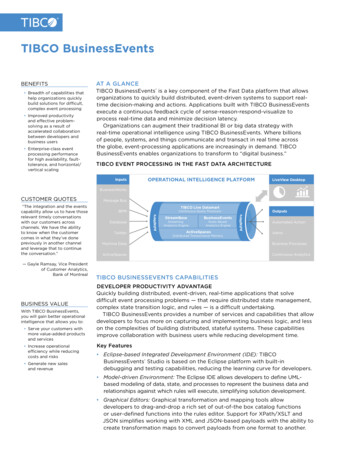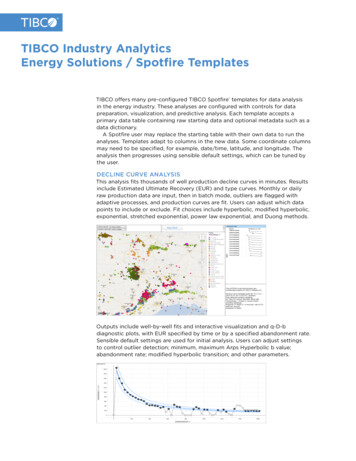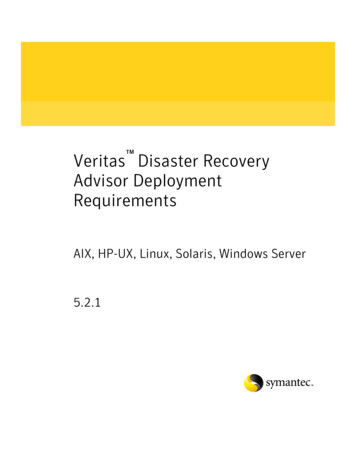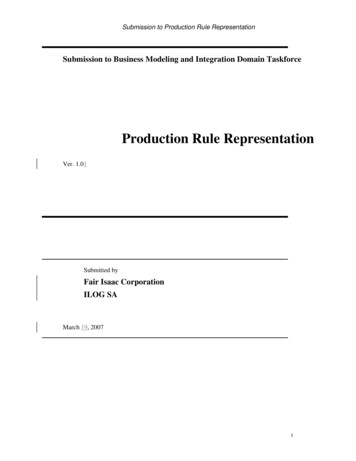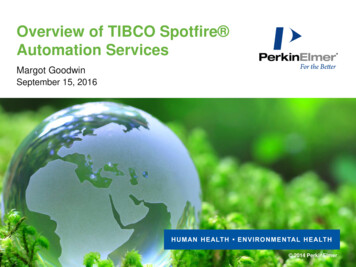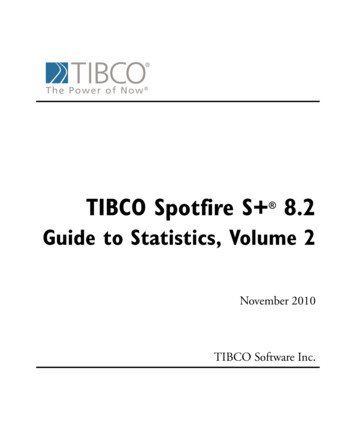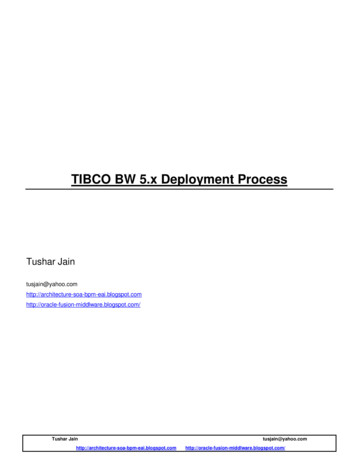
Transcription
TIBCO BW 5.x Deployment ProcessTushar spot.com/Tushar spot.com/
TIBCO BW 5.X Deployment n@yahoo.comPage 2 of 47Table of Contents1.INTRODUCTION .42.TIBCO OVERVIEW .5BusinessWorks.5Administrator Server .6Enterprise Message Service .6Business Connect .6Hawk6CONFIGURATION FILE. 6BusinessWorks Projects .63.HIERARCHY & NAVIGATION .7HIERARCHY. 7NAVIGATING TO APPLICATION CONFIGURATION . 8NAVIGATING TO PROCESS ARCHIVE (.PAR) / ADAPTER ARCHIVE (.AAR) CONFIGURATION . 9NAVIGATING TO SERVICE INSTANCE CONFIGURATION . 94.DEPLOYMENTS - ENVIRONMENT SPECIFIC INFORMATION .11GLOBAL VARIABLES . 11TARGET MACHINES (CONTAINERS) . 115.DEPLOYMENT TYPES .126.NEW APPLICATION – NEW EAR DEPLOYMENT .13TIBCO ENTERPRISE ARCHIVE (.EAR) FILE . 13LOGON TO ADMINISTRATOR . 13Administrator GUI URL .13Logon13CREATING NEW APPLICATION . 14Creating New Folder .14Uploading EAR File.15CREATING SERVICE INSTANCE FOR PROCESS ARCHIVE (.PAR) . 20CREATING SERVICE INSTANCE FOR ADAPTER ARCHIVE (.AAR). 24COMPLETE THE DEPLOYMENT CONFIGURATION . 247.EXISTING APPLICATION – REVISED EAR DEPLOYMENT.24UPLOADING NEW VERSION OF EAR . 24CREATING SERVICE INSTANCES FOR NEWLY ADDED PAR/AAR . 24COMPLETE THE DEPLOYMENT CONFIGURATION . 248.EXISTING APPLICATION - REVISED CONFIGURATION DEPLOYMENT.249.DEPLOYMENT CONFIGURATION .24CONFIGURING APPLICATION. 24Global Variables .24CONFIGURING PROCESS ARCHIVE (.PAR) . 24Monitoring 24Rulebases 24Events24Failure Count . 24Advanced Configuration.24Runtime variables . 24TIBCO BW 5.X Deployment n@yahoo.comPage 2 of 47
TIBCO BW 5.X Deployment n@yahoo.comPage 3 of 47TIBCO BusinessWorks Checkpoint Data Repository . 24TIBCO BusinessWorks Process . 24CONFIGURING SERVICE INSTANCE OF PROCESS ARCHIVE . 24CONFIGURING ADAPTER ARCHIVE (.AAR) . 24Monitoring 24Advance 24Adapter SDK Properties . 24Runtime variables . 24CONFIGURING SERVICE INSTANCE OF ADAPTER ARCHIVE . 2410.DEPLOYING, STOPPING/STARTING INSTANCES.24DEPLOYING APPLICATION . 24STARTING / STOPPING SERVICE INSTANCES . 24Stopping Service Instances.24What you must know before stopping . 24Starting Service Instances.2411.COPYRIGHT AND DISCLAIMER .24TIBCO BW 5.X Deployment n@yahoo.comPage 3 of 47
TIBCO BW 5.X Deployment n@yahoo.comPage 4 of 471. IntroductionThis document lists the procedures for deploying TIBCO BW 5.x projects onto all environments (Development, Staging,Beta and Production). The intended audience for this document is project administrators and Production Controlpersonnel. Developers can also refer to this document to understand the deployment process.This document covers the initial release and subsequent deployments of projects but not the initial installation or setupof the administration server, domain, or adapters or any application specific deployment procedures (e.g. databasechanges, application server changes, etc.). This document does not cover the deployment and configuration of otherTIBCO Components, such as BusinessConnect, EMS, and Hawk. The reader of this document is suggested to consultthe appropriate documentation for the deployment and configuration of other TIBCO components.The reader of this document is assumed to have a basic familiarity with TIBCO products, including Rendezvous,Administrator, and Business Works. Documentation on setting up the development environment and how the files aremaintained within ClearCase is described in the TIBCO development/version control document.Deployment OverviewDeploying TIBCO projects is similar to deployments of enterprise java applications: a setup process that occurs on theinitial release of the project, and a process of deploying newer versions of the project by replacing the binary file(s) witha newer version and restarting the application. However, differences exist on how these processes are actuallyconducted. In order to understand these processes, it is important to understand TIBCO and how projectsconfigurations are maintained.TIBCO BW 5.X Deployment n@yahoo.comPage 4 of 47
TIBCO BW 5.X Deployment n@yahoo.comPage 5 of 472. TIBCO OverviewTIBCO provides a common messaging infrastructure and workflow engine to help integrate applications & partners. Itaccomplishes these using adapters, BusinessWorks & BusinessConnect. The adapters help convert applicationspecific messages into a common format for transmission through the network using TIBCO’s messaginginfrastructure, or bus.BusinessWorks allows a user to configure the adapter and to create/manage processes between applications througha swing-based GUI called Designer.Machine AMachine BApplicationApplicationAdapterAdapterMachine CBusinessWorksTIBCO Bus (Network)Administration ServerProcessEngineAdapterApplicationMachine FMachine EMachine DFigure 1: Example BusinessWorks environmentAs shown in this example, adapters are individually configured to provide an interface between the application andTIBCO’s message bus. A user can then create specific process flows, or process definitions, between theapplications. These process definitions are then deployed onto a process engine that is deployed on a machine.A sample process definition may be to take user input from an application (machine A), update the database (machineB), and then update the mainframe (machine C). Although each application provides specific functionality, it is theprocess definition that brings the functionality together in either a synchronous or asynchronous fashion.BusinessWorksBusinessWorks provides a GUI to allow a user the ability to configure adapters and create/manage process definitions.In addition, BusinessWorks is used to deploy the adapter configurations and process engines onto a specific machineor set of machines.TIBCO BW 5.X Deployment n@yahoo.comPage 5 of 47
TIBCO BW 5.X Deployment n@yahoo.comPage 6 of 47The adapter configuration, process definition, and deployment are stored together as a single TIBCO project. Thisproject can then be started and stopped by the Administration Server.Administrator ServerThe Administrator Server helps manage all the projects within its domain. A domain in TIBCO is a logical grouping ofmachines and projects. Every domain will have one primary Administrator Server & additional secondary servers.Once the project (adapter configuration, process definition, deployment) is set in BusinessWorks, the information istransmitted to the Administrator Server using Enterprise Archive (EAR) File.Whenever an adapter or process engine instance starts, it first requests the configuration information from theAdministrator Server. This information is then cached on the adapter/process engine’s local machine. Currently, theonly time the configuration information is re-requested from the Administration Server is when the instance is restarted.Consequently, whenever changes are made to a configuration or process definition is modified and saved onto theAdministration Server, the adapter or process engine instance must be restarted to reflect the changes. Startup scriptsare provided locally for each adapter and process engine. In addition, the Administration Server provides a web-basedGUI to start and stop projects.Enterprise Message ServiceTIBCO EMS software allows you to send messages from your applications according to the Java Messaging Service(JMS) protocol. The software also extends the JMS protocol with delivery extensions such as reliable message deliveryand no-acknowledge message receipt mode.The EMS 4.1 conforms to Java Message Service 1.1 specification.Business ConnectTIBCO BusinessConnect is the integration platform that provides connectivity to trading partners over the Internet.TIBCO BusinessConnect has a GUI-based configuration environment for setting up PIPs and trading partners.HawkTIBCO Hawk is used as a tool for monitoring and managing distributed applications and operating systems. In thepartner connectivity gateway, Hawk is used for monitoring, alerts, and notifications of the public and private process.Configuration FileBusinessWorks ProjectsThe entire project information is stored on file system as a multi-file project. Designer GUI is used to modify thisproject. Once development is complete, Enterprise Archive (EAR) file is created using designer. Then this EAR files isdeployed using Administrator.TIBCO BW 5.X Deployment n@yahoo.comPage 6 of 47
TIBCO BW 5.X Deployment n@yahoo.comPage 7 of 473. Hierarchy & NavigationHierarchyThe Enterprise Archive (EAR) file contains any number of Process Archives (.PAR) and/or Adapter Archives (.AAR).Thus hierarchy of any EAR is similar to below,EAR Name (Application) PAR 1 (Service) Machine 1 (Container) Machine n (Container) PAR n Machine 1 (Container) AAR 1 Machine 1 (Container) Machine n (Container) AAR n Machine 1 (Container)In administrator, “Application” needs to be created for any EAR to be deployed. Multiple applications can be createdusing same EAR. All the PARs & AARs inside EAR needs to be deployed on one or more target machine(s). SamePAR can be deployed on same machine multiple times. Each instance of PAR or AAR deployed on target machine iscalled “Service Instance”. The target machine is also called as “Container”.All the applications reside under “Application Management” folder in the Administrator. Sub-folders can be createdunder “Application Management” folder and applications can be created under these sub-folders.Guideline for production,-One folder will be created under “Application Management” for each protocol.-One EAR file will be created for each protocol. This EAR file will contain all the PARs/AARs for thatprotocol.-Two Applications will be created for each EAR, One for each production server.-Two Service Instances will be created using same Target Machine for each PAR. One Serviceinstance will be configured as “Primary” whereas other service instance will be configured as“Secondary”-One Service Instance will be created for each AAR.TIBCO BW 5.X Deployment n@yahoo.comPage 7 of 47
TIBCO BW 5.X Deployment mtusjain@yahoo.comPage 8 of g conventionsName/ParamterConventionFolder NameUse short names as far as possible.Example:RN (for RosettaNet)CXMLEDISOAPCustomApplication Name Folder Name Target Machine Suffix Example:RN 314EDI 600JApplication Repository Name Domain - Application Name Name of Primary Service Instance of PAR Use short and yet meaningful names forservice. Use the suffix for FT Setup PAR Name P for Primary, when setup in FT PAR Name S for Secondary, when setup in FTName of Service Instance of AAR AAR Name Navigating to Application ConfigurationOn left side frame of the administrator GUI, Click on the “ ” in front of “Application Management” to expand it, thenclick on “ ” in front of folder in which application resides to expand it, and then click on “ ” in front of Application. Thenclick on “Configuration”. Screen like below is displayed,TIBCO BW 5.X Deployment n@yahoo.comPage 8 of 47
TIBCO BW 5.X Deployment n@yahoo.comPage 9 of 47Navigating to Process Archive (.par) / Adapter Archive (.aar) ConfigurationNavigate to corresponding Application Configuration using section 0Now on right side frame, click on “ ” in front of “ EAR Name ” to expand it if it is not already expanded. Screen likebelow is displayed,Navigating to Service Instance ConfigurationNavigate to corresponding Process Archive or Adapter Archive using section 0TIBCO BW 5.X Deployment n@yahoo.comPage 9 of 47
TIBCO BW 5.X Deployment n@yahoo.comPage 10 of 47Now on right side frame, click on “ ” in front of “ Process Archive Name .par” or Adapter Archive Name .aar” toexpand it. Screen like below is displayed.TIBCO BW 5.X Deployment n@yahoo.comPage 10 of 47
TIBCO BW 5.X Deployment n@yahoo.comPage 11 of 474. Deployments - Environment Specific InformationAlthough most of the project information will be the same between environments, there are two specific componentsthat will be different between environments, from BW Project deployment perspective: global variables, and the targetmachines the adapter instances or process engines will be deployed upon.Global VariablesGlobal variables are used within the deployment process to maintain environment specific values. Initially, this willinclude values such as port number and subject name but may be expanded based on the project requirements, suchas database or mainframe connectivity information. Having different port numbers and subject names based on theenvironment ensures that messages from a project in one environment are not inadvertently picked up by same projectin another environment.Target Machines (Containers)When a project is deployed onto a non-development environment, the adapters and process engines will be deployedonto machines that are specific to the environment. For instance, in development, the adapters and process enginesmay be deployed on machine TIBCODEV, whereas in QA they will be deployed on QA02, and in Production they aredeployed on APP01.TIBCO BW 5.X Deployment n@yahoo.comPage 11 of 47
TIBCO BW 5.X Deployment n@yahoo.comPage 12 of 475. Deployment TypesTIBCO deployment can be categorized in following manner,1. New Application – New EAR Deployment2. Existing Application – Revised EAR Deployment3. Existing Application - Revised Configuration deploymentTIBCO BW 5.X Deployment n@yahoo.comPage 12 of 47
TIBCO BW 5.X Deployment n@yahoo.comPage 13 of 476. New Application – New EAR DeploymentWhen a project is ready to be deployed initially in a new environment, certain steps must occur for deployment. TIBCOAdministrator is used for this purpose. All these steps are mentioned below.TIBCO Enterprise Archive (.ear) FileAfter development is complete, a Enterprise Archive file (.ear) that contains all the latest project information should bebuilt from Designer tool. This .ear file should be copied to the file system of a machine that can be accessed by thedeployment team.Logon to AdministratorAdministrator GUI URLOnce the .ear file has been placed in the proper location, it will be deployed using administrator GUI. Administrator GUIurl is http:// HostName : port /servlet/tibco administrator, where AdminServerName is the machine name of theserver, on which Administrator Server is running and port is port number on which Administrator server is running. Ifthere are Administrator servers running in FT mode (one primary and the other failover), then primary administratormust be used for the deployments, otherwise the deployment may fail. The Administrator GUI URL will differ based onenvironment.LogonOpen Web browser & go to Administrator GUI URL for given environment/domain. Logon window will be shown asfollows,Verify that Domain is correct.After logging in to the Administrator GUI, with the appropriate credentials, the user is presented with the domainmanagement screen, similar to the one shown below.TIBCO BW 5.X Deployment n@yahoo.comPage 13 of 47
TIBCO BW 5.X Deployment n@yahoo.comPage 14 of 47Creating new applicationClick on the “Application Management” on the left hand side frame. That will display deployed applications on the righthand side frame. The screen will look as below,Creating New FolderCheck if folder already exists. Skip this step if folder exists.TIBCO BW 5.X Deployment n@yahoo.comPage 14 of 47
TIBCO BW 5.X Deployment n@yahoo.comPage 15 of 47Click on “New Folder” button located at top-right, which will display “New Folder” screen as below. Specify Name,Description & Contact.Click on “Save” button (located at right) to create folder. Screen will refreshed & look like below,Uploading EAR FileClick on the folder in which application should reside, screen will look like below,TIBCO BW 5.X Deployment n@yahoo.comPage 15 of 47
TIBCO BW 5.X Deployment n@yahoo.comPage 16 of 47Click on “New Application”. Upload EAR screen will be shown as below,TIBCO BW 5.X Deployment n@yahoo.comPage 16 of 47
TIBCO BW 5.X Deployment n@yahoo.comPage 17 of 47Select the ear using “browse” button & click OK. New Application Configuration screen as shown below is displayed.Specify the application parameters.-Name: Name of the application-TIBCO Application Repository Name: EAR File Name-Description: Description of this application-Contact: Developer(s) responsible for this application deploymentRefer to the naming conventions for naming the application and services in a standard way.Then “Uncheck” the box “Quick Configure”. Screen will look like below,TIBCO BW 5.X Deployment n@yahoo.comPage 17 of 47
TIBCO BW 5.X Deployment n@yahoo.comPage 18 of 47Click on Save. New Application will be created & screen will look like below,TIBCO BW 5.X Deployment n@yahoo.comPage 18 of 47
TIBCO BW 5.X Deployment n@yahoo.comPage 19 of 47TIBCO BW 5.X Deployment n@yahoo.comPage 19 of 47
TIBCO BW 5.X Deployment n@yahoo.comPage 20 of 47Creating Service Instance for Process Archive (.par)Navigate to Application Configuration under which Process Archive resides referring section 0. Screen will look likebelow,Click on Configuration, Screen will look like below,TIBCO BW 5.X Deployment n@yahoo.comPage 20 of 47
TIBCO BW 5.X Deployment n@yahoo.comPage 21 of 47Click on the “ Process Archive .par” to be deployed. Screen like below will be displayed,Click on “Add to Addional Machines”. “Bind to Container(s)” screen will be displayed like below,TIBCO BW 5.X Deployment n@yahoo.comPage 21 of 47
TIBCO BW 5.X Deployment n@yahoo.comPage 22 of 47Click “Checkbox” in front of Target Machine Name to be selected in “Machine” column. Screen will look like below,Click OK. Machine Target Machine Name will be added & screen will look like below.TIBCO BW 5.X Deployment n@yahoo.comPage 22 of 47
TIBCO BW 5.X Deployment n@yahoo.comPage 23 of 47Click on “Save”. Screen will look like below,Click on “ ” in front of “Deployment Configuration EAR Name ” to expand. Then Click on “ ” in front of ProcessArchive .par. Screen will look like below,TIBCO BW 5.X Deployment n@yahoo.comPage 23 of 47
TIBCO BW 5.X Deployment n@yahoo.comPage 24 of 47Click on Service Instance created in previous step under Process Archive Name .par. “Edit Service Instance”screen will be displayed as below. Set Service Instance name correctly and click on Save.Once saved the configuration for Service, the Application Configuration view will be displayed as shown below. Clickon “ ” in front of “Deployment Configuration EAR Name ” to expand. Then Click on “ ” in front of ProcessArchive .par. Screen will look like below,TIBCO BW 5.X Deployment n@yahoo.comPage 24 of 47
TIBCO BW 5.X Deployment n@yahoo.comPage 25 of 47If MULTIPLE service instances need to be created for same Process Archive (.par) then refer the followinginstructions.Click on the Process Archive .par. Screen like below will be displayed,Again click on “Add to Addiotional Machines“. Bind to Container(s)” screen will be displayed like below,TIBCO BW 5.X Deployment n@yahoo.comPage 25 of 47
TIBCO BW 5.X Deployment n@yahoo.comPage 26 of 47Enable “Checkbox” in front of Target Machine Name to be selected in “Machine” column. Screen will look like below,Click “OK”. Target Target Machine Name will be added and screen will look like below,TIBCO BW 5.X Deployment n@yahoo.comPage 26 of 47
TIBCO BW 5.X Deployment n@yahoo.comPage 27 of 47In “General” section, Ensure that “Enable Service” checkbox is “ON”Note that some deployments may need special requirements for setting FT parameters. Set the FT Parameters asrequired for this deployment. Deployment Configuration document should correctly identify the settings for FT.NAMING CONVENTION: When deploying a PAR with Fault tolerant configuration, add suffix “ P” to the “ServiceInstance Name” denoting the fault tolerant characteristic of t
TIBCO EMS software allows you to send messages from your applications according to the Java Messaging Service (JMS) protocol. The software also extends the JMS protocol with delivery extensions such as reliable message delivery and no-acknowledge message receipt mode. The EMS 4.1 conforms to Java Message Service 1.1 specification. Business Connect
